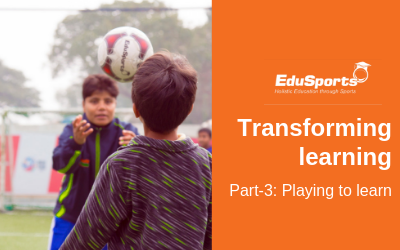“To succeed is to have failed” – learning from failures

Transforming learning: Part -3
(This article is the 3rd in a series on using play to transform learning for children)
It was a couple of years back that I chanced upon this Video of a group of teenage girls from a tribal area in Jharkhand – learning to play Football (supported by an NGO called: Yuwa ). It was at the end of the Video, when the interviewer asks one of the girls: a petite, dark girl with a dazzling smile, ‘Why do you play football?’. Her response had amazed me – I still get goosebumps every-time I recall this episode. Her answer in broken, halting English was: ‘I play football because it makes me feel as free as boys do’.
Just think about it – she did not speak of health, fitness, skills, glory, medals or anything typical sport is usually associated with. Instead, she spoke about her inner sense of ‘abandon’ – an emotion so deep and overwhelming – that can easily transform her life. And it will.
In my last article, I wrote about how sport or movement plays such a powerful role in improving the cognitive competence of children – which is fundamental to their learning in the classrooms. There is another equally important factor that can either turbo-charge or severely mar the learning and development of our children viz. their ’emotions or feelings’ – which is the focus of this piece.
We all know from our own experience that ’emotions’ is the essential criteria – on which we base most of our ‘rational’ decision making in our lives – including in any survival or social situations.
Development experts have long argued that we process all information and events – first through the filter of ’emotions’ – before the ‘logical response’ gets deployed through the body. In a series of telling experiments (Damasio), scientists demonstrated that when you dissociate the ’emotion’ and ‘body’ from the process of cognition – rational behavior and learning are absent.
Which also means, that if our children do not have an ’emotional commitment’ to ‘learning’ – they are not likely to learn very much. This, in my view, is by far the single biggest problem our schools are also facing today: how do you get the ’emotional commitment’ from the children required for any learning?
The idea of Play or Sport introduced at the start of this piece can help solve this conundrum beautifully.
‘How‘, you ask? Read on.
So we know that an ’emotional commitment’ from the learner is a necessary condition for any learning to happen. We have also found that it is relatively easier for any of us to make that commitment – if we ‘anticipate’ a sense of fun, pleasure or adventure before engaging ourselves in any experience.
As covered in my earlier piece, play or movement exists as a natural impulse in all of us – and Play, by and of itself, engenders the feelings of pleasure, and adventure (‘make-believe’) in the participants.
So how does it help us getting the emotional commitment? Let me outline two simple examples – to illustrate this point further:
Imagine a bunch of kids playing a game of ‘seven stones’ (also called as Pittu or Lagori in different parts of India). Their act here requires them to take a series of rapid decisions every step of the game – right from how should they throw the ball – to which place would they dash to if the ball hits the stones – and the manner in which they would come together to fix the stones and so on. And they do this by drawing solely upon their cognitive or cerebral process – working in concert with their bodies. At the end of the session, let’s assume an adult (teacher or a parent) walks up to these children – and calls out the fact that she (the teacher) noticed them taking some highly intelligent (cerebral) calls or decisions while they were playing – and goes on to discuss the merits of some of these decisions to some detail.
Am not sure if you noticed, but something wonderful just happened here. Here’s a quick analysis:
1. By playing of their own volition – (unbeknownst to them) children are activating parts of their brain, chiefly the cerebellum – responsible for cognition and motor competence – strengthening their neural connections further.
2. The adult’s timely intervention also helped reinforce the link between the act of Play and their (children’s) innate ability to think or reason well – leaving a residue of positive emotion or inner experience for the children.
Do you think that there is a higher chance that children playing ‘seven stones’ will have a stronger emotional commitment or pre-disposition to say – a downstream math or science class? There’s huge amount of data & evidence around the globe (and from our work with children in schools for the past decade) that supports this assertion.
For my second example on how Play can influence emotions in learning environments, I’d like to bring back the game of football the tribal girls are learning to play (outlined at the start of this piece). It is evident that the protagonist of my story in that game, is able to operate in an ‘alternate reality’ or a ‘make-believe’ land (attributes of Play) in which she feels free or equal to anyone else – at least that’s her inner experience. These ‘feelings’ – although felt in an alternate reality – not only will become part of her psyche or consciousness – but will soon pervade beyond the game of football into ‘real life’ – changing, transforming her from the core.
Deep ties bind thought, emotion and movement – a fact illuminated whenever someone steps out to play. Like that of the tribal girl in the story, we can also change our children’s ‘reality’ by changing their attention and feelings towards it. Play can change their lives. And the clock is ticking.
 Author
Parminder Gill
(Co-founder and Head of Business)
Author
Parminder Gill
(Co-founder and Head of Business)
 Author
Parminder Gill
(Co-founder and Head of Business)
Author
Parminder Gill
(Co-founder and Head of Business) 





